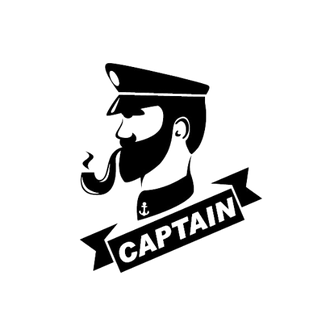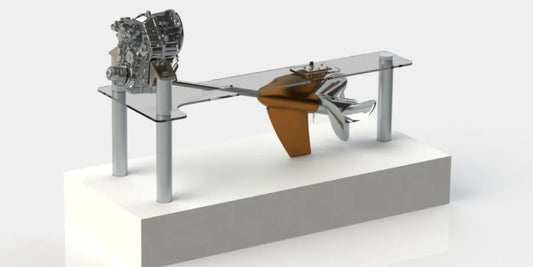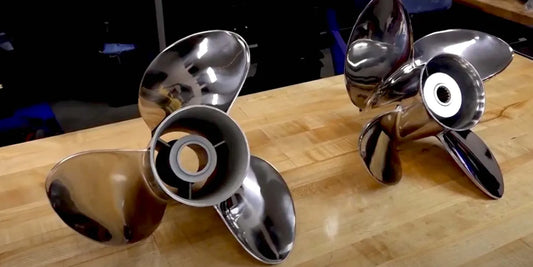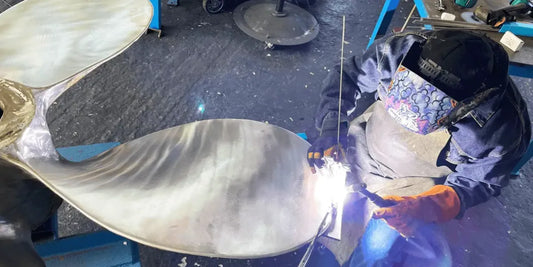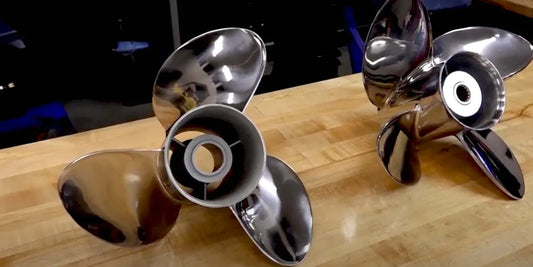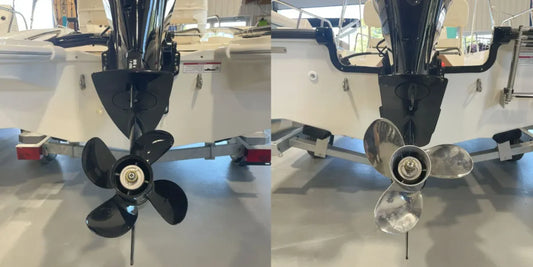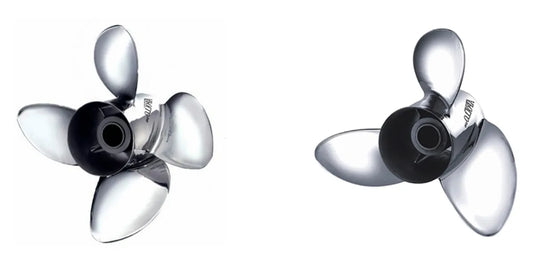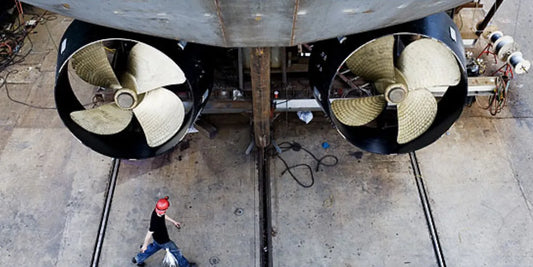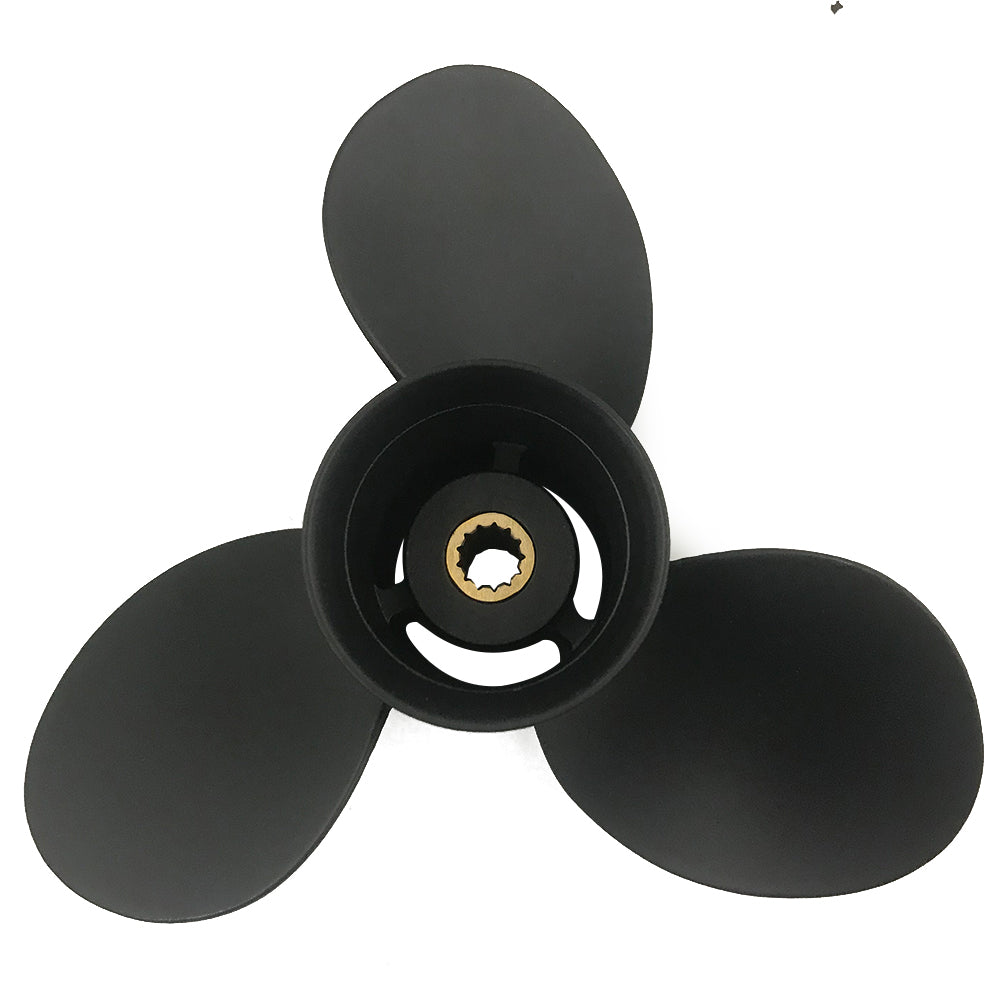In terms of a proper propeller, the choice can make or break your boating experience. For many, the debate between 3-blade and 4-blade propellers is confusing when trying to determine which one offers better performance, efficiency, and versatility. Each might be better depending on factors such as speed, handling, or specific types of boating. We will explore in depth the significant differences between these two propellers to help you make an educated choice depending on your requirements. Whether it's for superior acceleration, better fuel efficiency, or smoother handling, having knowledge of the nitty-gritty details of 3-blade versus 4-blade propellers will give you an edge to fine-tune your boat accordingly for optimal performance.
Introduction to Propeller Design

What Is a Prop and How Does It Function?
Usually called a "prop," a propeller is a necessary piece in a boat's drive system. It functions by developing thrust from the rotation imparted by the engine, propelling the vessel through the water. The blades of a propeller are angled and curved to spin, causing differences in water pressure. When one side of the blade has lower water pressure, the other side has higher pressure. This pressure difference causes forward thrust and efficient propulsion of the boat.
With progress in materials engineering and hydrodynamics, modern propeller design has been working to extract maximum performance in all scenarios. Different variables, including the number of blades, pitch, diameter, and rake angle, influence the prop's clean-water conditions. A 3-blade prop is typically faster and more efficient, while a 4-blade prop favors smoother handling and control in rough waters. A boat owner can fine-tune these characteristics towards a compromise between acceleration, top speed, economy, and overall use. Advances in manufacturing now provide a range of customized options for everything from occasional recreation to competitive boating. Understanding how props work and what affects their performance benefits in improving your overall experience on the water.
Blade Type Overview: 3-Blade vs 4-Blade
The contrasting viewpoints of 3 and 4 blades discuss the trade-offs in performance and various usage scenarios. Typically, a 3-blade propeller is chosen to prioritize top speed and potentially improve fuel efficiency. The drag is reduced by design for higher RPMs, making it ideal for water skiing or any situation where gaining speed and achieving maximum speed is a priority. Additionally, they operate smoothly at higher speeds due to their design.
In providing control, acceleration, and thrust in rough water, 4-blade propellers are far superior. They usually ensure an even power delivery, stability at low speeds, and during turns. Thus, you do great for either fishing or towing, or traversing choppy waters. They usually take a slight hit on top speed compared to 3-blade options, and downhill cruising with 4-blade propellers, which spread power well and have less slip, is often far better in terms of fuel economy.
The choice between a 3-blade or 4-blade propeller should be made by considering the boat's purpose, the environment in which it will be used, and the desired type of performance. Achieving a balance in these considerations will give a boat owner the best in terms of function and enjoyment, whether the boat is being used for speed, stability, or versatility.
Starting with the Proper Choice of Propeller Blade
The propeller configuration must be appropriately selected to extract the best performance and efficiency from the boat. Although a proper match allows for greater speed and stability, it also improves fuel economy and reduces engine wear. For instance, 3-blade propellers, as the name suggests, are often chosen to achieve a higher top speed, and water skiing or racing are some examples. The 4-blade propellers, however, provide more thrust at lower speeds, offer better handling in rough water, and achieve faster acceleration that may be needed in fishing or cruising scenarios.
Industry studies indicate that fuel economy can increase by approximately 10% in low-speed operations with 4-blade props, primarily due to their improved water-holding capabilities. On the other hand, 3-blade models tend to reduce drag at high speeds and hence, remain the favorite choice for recreational powerboats. The choice of material and pitch also plays a role in the propellers' performance, with stainless steel offering better wear resistance and a higher level of finish than aluminum.
Ultimately, understanding the nature of your vessel and its operating condition will inform your final decisions regarding blade configurations. Whether it is speed, fuel economy, or maneuverability that matters the most to you, the choice of the propeller will surely bring the final touch to your boat experiences.
Performance Comparison: 3 Blade Prop vs 4 Blade Prop

Speed and Acceleration Differences
Unlike speed and acceleration, three- and four-blade propellers present very different performance characteristics. Usually, a 3-blade propeller would be favored to reach top speeds because of its lower drag in the water. Acceleration and top-end velocity are somewhat negligible attributes of the 3-blade propellers, as their design makes them very agile. Speedboats and applications requiring quick movement are therefore the perfect instances.
Conversely, 4-blade propellers are employed for utmost efficiency at slow speeds. They provide much smoother handling, better grip in the water, and higher thrust than a 3-blade propeller, and can stand up well in conditions where stability and fuel efficiency are priorities, such as dock cruising or towing. Maximum speed or better and steady acceleration-these propeller-specific considerations must be underlined and comprehended; thus, the choice of propeller is well-matched to meet its intended application.
Fuel Efficiency: Which Propeller Wins?
The key to fuel efficiency lies in a tradeoff between engine performance and operating conditions among different types of propellers. Three-blade propellers are often the preferred choice due to their lighter weight, which offers less drag and improved fuel efficiency at medium loads and speeds. Less strain is put on a three-blade-propeller engine, which runs more smoothly and consumes less fuel during cruising.
Four-blade propellers, however, because of the extra blade area, tend to consume slightly more fuel but are much more efficient when more stability or power is involved, such as in towing and rough waters. Moreover, improvements in materials, blade shapes, and pitch optimization have made the two types nearly equal in terms of fuel efficiency. Matching propellers to the specific boating conditions and loads will not only turn the tide in favor of saving fuel but also maintain the long-term efficiency of the engines.
Handling and Maneuverability Insights
In terms of handling and maneuverability systems, selecting the proper propeller would yield maximum performance in various situations. Blade numbers, pitch, and diameter are responsiveness-related factors that influence the design of steering systems. In the fight for three-blade props, they are said to accelerate faster and provide better control, suitable for small or quick boats. Four-blade props, however, can provide good handling in choppy waters for smoother navigation of heavier-laden vessels or working in abrasively marine-conditioned.
With further enhancements to propeller technology, maneuverability is supported by variable pitch adjustments and blade cup designs. These configurations enable precise control during slow-speed operations, such as docking and sharp turns, while promoting propulsion efficiency at high speeds. Properly matching your propeller's design to your vessel's design and expected use will maximize responsiveness and navigational control, providing a safe and enjoyable boating experience.
Application Scenarios for Each Propeller Type

Best Uses for Three-Blade Propellers
These three-blade propellers are used in a vast range of applications due to their versatile design and are thus among the most commonly used by boat owners. Such propellers constitute a balanced combination of speed, efficiency, and maneuverability. They are most suited for recreational boats, powerboats, and light commercial vessels where thrust and top-end speed need to be balanced.
A 3-blade propeller is more drag-producing than the 4-blade one, thus making it suitable for applications where top speed is one primary consideration. They provide better acceleration, especially in open water conditions where stability in rough waves is not as demanding as tight maneuvering. For vessels that require rapid acceleration, such as fishing vessels or water-skiing boats, 3-blade propellers provide efficient power to get the ships on plane.
With advancements in the materials and hydrodynamics of 3-bladed propellers, they can now operate under easier conditions while maintaining their durability and peak performance. This also makes them ideal for all kinds of cruising, whether for pleasure or work-related boating, where speed and versatility are top priorities.
One Needs to Have a 4-Blade Propeller
The enhancement to handling, greater fuel efficiency, and better performance under heavy loads will require the aid of a 4-blade propeller. This propeller is most suitable for boats that require increased stability and reliability, such as pontoons, larger fishing vessels, or boats that often navigate through rough waters. You will experience smoother acceleration with reduced vibrations and increased thrust at lower speeds in the 4-blade design, making it preferred for trolling or towing water sports equipment.
Data indicate that 4-blade propellers excel in speed-holding and vehicle control, particularly for vessels navigating choppy waters, and hence the moniker "speed-holding propellers." They exert some bite into the water so that the propeller does not slip during hard turns or quick decelerations. Another benefit is that these propellers provide better balance, which contributes to improved fuel economy over long distances. For the boater who needs strength, efficiency, and smooth operation all rolled into one, a four-blade system will perform in demanding conditions while retaining its strength for many years.
Environmental Considerations and Boat Type
To select the suitable propellers, it is essential to consider the elements of the surroundings and the type of boat for optimal performance. For instance, water types, ranging from freshwater lakes and brackish estuaries to open saltwater seas, demand different considerations of propeller needs. In certain saltwater conditions, the stainless steel variant is best suited because of its corrosion resistance, while aluminum propellers may be the more economical choice for freshwater.
Boat types have become an essential factor in selecting propellers. 3-blade propellers, for example, give high speeds to speedboats. Pontoon boats, emphasizing stability and low-speed maneuverability, are better served by 4-blade propellers. Hybrid-electric power boats have gained significant recognition over the years, and as a result, many manufacturers design propellers that maximize energy efficiency and minimize the environmental impact.
This combination of boat designs and operating waters should inform boaters' decisions about meeting their needs while minimizing environmental strain.
Installation and Maintenance of Propellers

Installing a 3-Blade vs a 4-Blade Prop
The installation of a 3-blade or 4-blade propeller means assessing your vessel performance requirements and intended use. Generally, 3-blade propellers are designed for higher top speeds, particularly in boats used for competitive or recreational activities that require quick acceleration and velocity. On the contrary, 4-blade propellers offer smoother handling, greater low-end control, and improved fuel efficiency, especially beneficial when the boat is used for towing water sports equipment, fishing in rough conditions, or cruising at consistent speeds.
While installing, maintain the preference of propeller materials within the compatible requirements of your watercraft. Steel and aluminum are popular finishes since they offer durability and good performance. Stainless steel offers better efficiency due to its higher strength and reduced flexibility in propelling, whereas aluminum is lighter in weight and more energy-efficient. Moreover, the rigging and installation require high precision with an optimal level of balance, so that vibrations caused by improper balance may damage the motor or reduce its efficiency over time.
The pitch and diameter of the propellers may need to be adjusted to changes in the load and operating conditions of your boat. For example, a high-pitch propeller facilitates faster speeds but needs more power from the engine, while a low-pitch propeller provides fast acceleration with less effort from the engine. Regular maintenance, including cleaning and inspection for dings or cracks, will ensure optimal performance levels and long retention for both 3-blade and 4-blade propellers.
Understanding each propeller's specific characteristics and carefully installing it into a boat would enhance the overall performance, framing, energy efficiency, and other operational purposes.
Maintenance Tips for Propeller Performance
Proper and proactive maintenance is required to maintain the longevity and optimum operational efficiency of the propeller. Inspect the prop for any damage that may affect its efficiency, such as cracking, denting, or corrosion. Cleaning the prop is crucial, as it should be free from debris, marine growth, and dirt accumulation. Use a soft brush in conjunction with a non-corrosive cleaning solution. Furthermore, inspect the shaft for any fishing line or debris that could cause internal damage or engine overheating.
Lubrication of the propeller shaft at regular intervals prevents corrosion and ensures the propeller operates smoothly. Keep the nut tightly secured using a suitable wrench, but avoid over-tightening it to prevent distortion of the hub. Record details of propeller wear and usage in given intervals to determine wear trends. With maintenance, coating the propeller with a marine-grade protective coating may serve to increase its life. Following these maintenance tips shall not only contribute to the prolonged service life of your propeller but also to the constant performance of your boat.
Wear-Indicating Signs: The Blade Propeller Replacement Time
Knowing when an aluminum propeller has to be changed lies at the core of ensuring maximum operational performance while avoiding vessel damage. Those above include bent blades, chipped ones, cracked blades, or even slight dents, all resulting from scrubbing rides in deep and harsh waters. Any tiny dent or imperfection can put the propeller out of balance, thus impairing performance and creating vibrations that may someday harm your engine system.
Another key indicator is decreased speed and acceleration when actual smooth running at normal engine RPM is observed. Disengaged performance suggests that the propeller is losing its ability to impart effective energy. Excessive cavitation-bubbling or weird noises when in operation signal that the damaged or worn surface of the propeller could be under discussion.
If the boat experiences difficulties in maintaining consistent fuel consumption or power output at any instance, then one should proceed to check the propeller. These symptoms may indicate that the propeller pitch or diameter no longer corresponds to the engine's requirements, possibly due to wear or deformation. Good practice dictates regular inspections and timely replacements to prevent long-term damage, thereby ensuring a safe and efficient boating experience.
Expert Opinions and User Experiences

Popular Reviews on 3-Blade and 4-Blade Propellers
To decide between 4-blade and 3-blade propellers, it ultimately comes down to individual priorities and boating requirements. As far as I have observed, a three-bladed prop is always a good option for general boating. They tend to offer top speed and reasonable fuel consumption, making them great for activities such as water skiing or cruising at higher speeds. Less drag from a 3-blade prop means less straining of an engine, which helps maintain uniform performance under different conditions.
The 4-blade propellers, on the other hand, offer good thrust and handling, especially at low speeds. From my perspective, these props are best suited for duties that demand better acceleration, such as towing wakeboards or precise maneuvering of the boat through choppy waters. Moreover, the extra blade provides an additional surface area for a better grip on water, which is particularly important for boaters who prioritize minimal vibration and stability. While 4-blade props are just a bit slower than 3-blade ones in terms of speed, they are often much better in aggregate efficiency and provide smoother functioning, especially in rough environments.
Finally, I suggest you weigh what matters most in your contemplated boating activities. If speed with economy is all you care about, the 3-blade will most probably do the trick for you. If control, fast acceleration, and stability are your top priorities, then the 4-blade is your best choice. You may want to test and make fine adjustments, along with the advice of reputable propeller dealers, to find the perfect choice for your boat.
Expert Opinions for Different Boating Purposes
The choice between 3-blade and 4-blade propellers depends on several different boating needs and priorities. I would personally favor 3-blade props if the major consideration is speed and fuel economy. These props provide higher top speed, making them an excellent choice for long-distance cruising or watersports where performance must be maximized and auto consumption minimized.
They are also lighter, which adds to their efficiency. I find them ideal for speedily and cheaply covering extremely long distances on the water.
On the other hand, a 4-blade prop is generally a better choice for boaters seeking greater control and stability, especially in harsh shore conditions or under heavier loads. They allow for better acceleration and provide a better feel in the hand while fishing, towing, or making tight maneuvers. I've come to realize that 4-blade props provide smoother rides and good grip under rough conditions; hence, they almost double your confidence on water.
I would suggest that you ponder your usual boating scenarios and jot down in your mind what you consider most pertinent—whether it is speed, acceleration, or control. Of course, sometimes simply going out with them both can teach some invaluable lessons about what suits your style best.
Reference Sources
-
3-Blade vs. 4-Blade Prop: What Are The Differences? - Reel Coquina Fishing
Explains the performance differences, including speed, fuel efficiency, and drag. -
3 Blade vs. 4 Blade Propeller - Michigan Wheel
Discusses the impact of blade count on pitch and overall performance. -
3 Blade vs. 4 Blade Propellers: What Are the Differences? - Boatsetter
Highlights performance at different RPM ranges and trade-offs between speed and control. -
3 Blade vs 4 Blade Opinions - Microskiff Forum
Offers insights from boating enthusiasts on speed, grip, and suitability for different boat types. -
Gas Powered Boats: 3 Blade vs 4 Blade - Bertram31 Forum
Compares top-end speed and cruising efficiency between 3-blade and 4-blade props.
Frequently Asked Questions (FAQs)
What are the differences in performance between 3-blade and 4-blade props?
There are several performance differences between a 3-blade and a 4-blade prop, particularly in terms of speed and efficiency. A 3-blade prop will generally give you a higher top speed because of less drag. The 4-blade, on the other hand, offers improved low-speed performance and holeshot. Having that extra blade increases the gross surface area of the blade, allowing it to achieve a better grip on the water at lower RPMs, which is crucial for torque delivery. This slowly builds the torque, which may be needed to tow water skiing quickly and enhance acceleration. However, it ultimately comes down to the type of application the boat is designed for and what it needs to accomplish.
What effect does the number of blades have on fuel economy?
The number of propeller blades has a significant impact on fuel consumption. Typically, a 3-blade propeller generates better fuel mileage at high speeds due to its low-drag profile. At the other end of the spectrum, 4-blade propellers generally offer better fuel efficiency in the lower-speed ranges, particularly in the water, providing better acceleration and requiring less horsepower. However, at top speeds, a larger surface area results in increased drag, which can lead to fuel inefficiency at higher speeds. Therefore, one should consider their operational speeds and conditions before selecting props for fuel economy.
Very high-performance applications are usually best suited for which propeller?
For high-end performance applications, it is vessel-dependent to decide between a 3-blade and a 4-blade prop. Generally, 3-blade propellers are considered faster and allow for more RPMs due to less drag. A 4-blade propeller is suitable when torque and acceleration are required, such as in racing or towing. Secondly, the 4-blade design comes into its own in alleviating vibrations and enhancing handling performance, making it a good match for high-performance setups that focus on agility and response.
Can a 4-blade propeller reduce cavitation?
Yes. Cavitation can be reduced with a 4-blade propeller, mainly for high-end performances. The added blade area offers a greater surface for water to act upon, hence cavitation bubbles would occur less on a 4-blade prop compared to one with three blades. This condition of performance is particularly relevant in maintaining thrust against the loss of power, especially at high r.p.m.s. Furthermore, the design of a 4-blade prop may help promote grip and stability attributes that can reduce cavitation problems. Thus, a 4-blade might well solve your cavitation problem should it exist with another prop.
What effects does the blade area have on performance?
The blade area plays a crucial role in the propeller's performance. A larger blade area, typically found in 4-blade propellers, can provide better thrust and holding power at low speeds, which in turn translates into quicker holeshots and improved handling. While these properties of high blade area result in some advantages at low speeds, they may also create drag that can hinder top speed. A high-speed 3-blade prop, with reduced blade area, would be advantageous, providing good mileage and performance at those speeds. Choosing the right balance for blade area depends on your boat's application and the contrasting performances that you need.
What is the best prop for my boat?
Specific considerations influence your decision on the type of prop that will best suit your boat, including the engine's power, the type of boat, and its intended use. Start by testing the present prop concerning speed, acceleration, and fuel consumption. You may want to consider choosing either a 3-blade or a 4-blade prop. Generally, for higher speeds, 3-blades would suffice, while 4-blades provide better backing performance at lower speeds. Other important factors include the pitch of the propellers, their diameter, and the blade design. Additionally, it is recommended that you consult with a propeller expert, who can guide you based on your boat's specifications and intended use.
